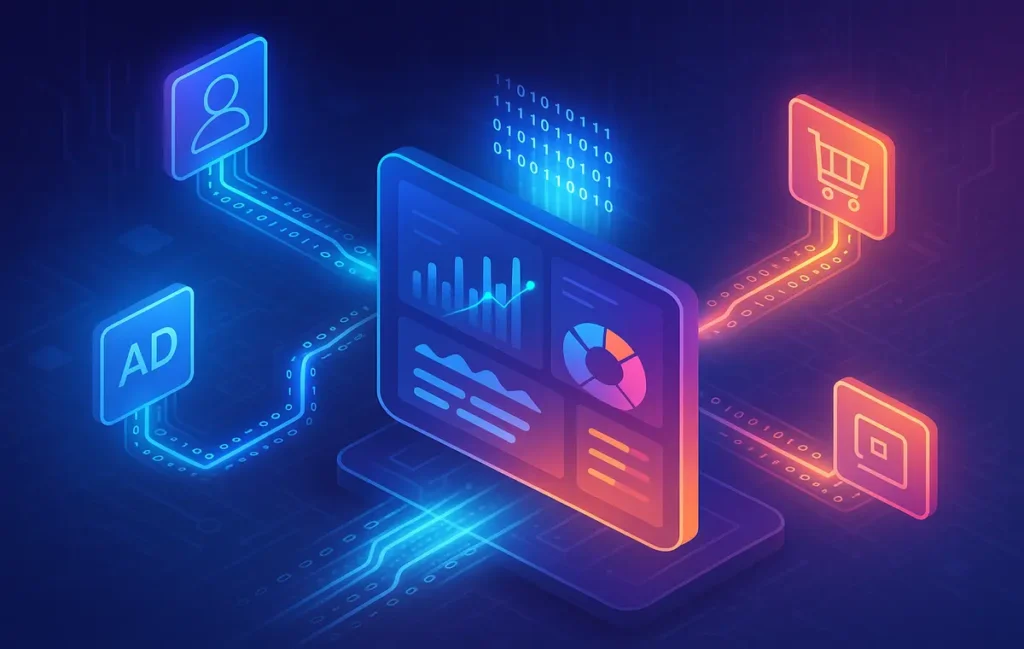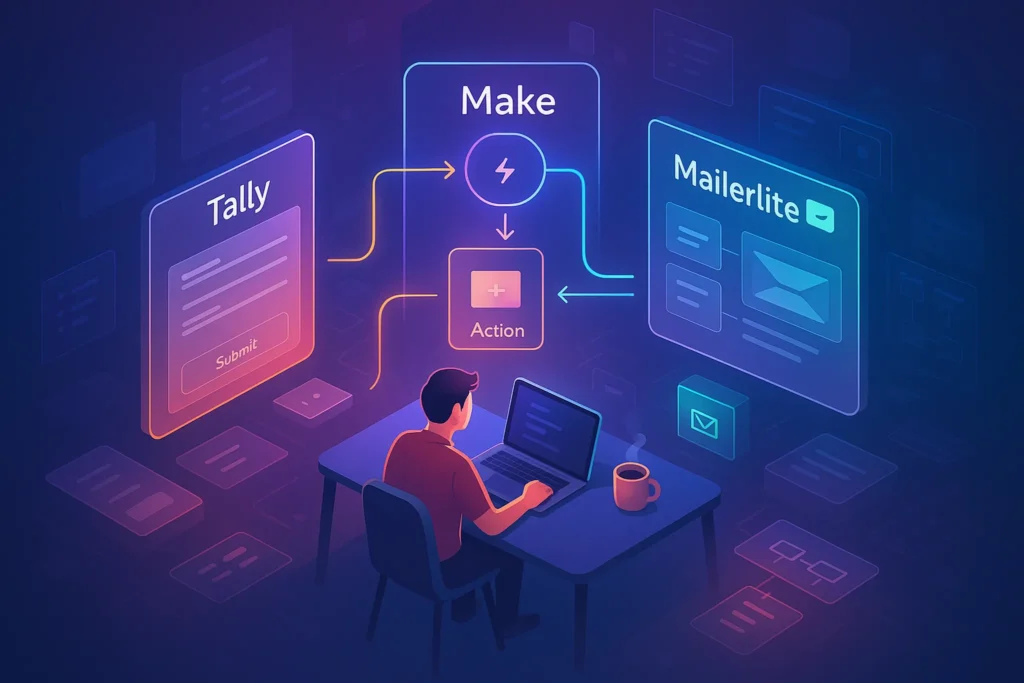🚧 The Marketer’s Data Dilemma
If you’re a modern marketer, chances are your data is scattered across half a dozen platforms—Google Ads, Facebook, HubSpot, Shopify, and a CRM. Building a single source of truth often feels impossible. Reports get delayed, campaigns run blind, and attribution turns into guesswork.
This fragmentation creates a daily headache. Marketing decisions need real-time clarity, but manually exporting CSVs or begging the data team isn’t scalable. That’s where data pipelines come in—automated systems that pull, clean, and deliver data exactly where you need it.
💡 Nerd Tip: Think of data pipelines as plumbing for your marketing stack. If the pipes are leaky or complex, the whole house suffers.
For those just starting with automation concepts, check out our Workflow Automation 101 to see how pipelines differ from everyday task automation.
📊 What Are Data Pipelines (for Marketers)?
At its core, a data pipeline automates ETL: Extract, Transform, and Load.
-
Extract: Pulling data from multiple sources (ad platforms, CRMs, ecommerce).
-
Transform: Cleaning, standardizing, and shaping the data so it’s usable.
-
Load: Delivering it into a warehouse, BI tool, or dashboard.
For marketers, this means not just moving numbers around, but ensuring your campaign spend, customer journeys, and ROI metrics are aligned. Unlike workflow automation (which is about task management) or marketing automation (email triggers, lead scoring), data pipelines focus on infrastructure for reporting and personalization.
💡 Nerd Tip: If you’re constantly asking “why doesn’t this dashboard match our ad spend?”, you probably need a pipeline.
For teams debating where pipelines fit in the stack, our CRM vs. Marketing Automation post breaks down how pipelines complement—not replace—your existing systems.
🧩 Why Marketers Need ETL Without the Headache
Traditional ETL tools were built for data engineers. They required SQL, scripting, and infrastructure knowledge. But marketers need answers fast, not weeks of dev work. The shift toward no-code ETL platforms is a game-changer.
Instead of waiting for technical support, marketers can connect Google Ads, Facebook, Shopify, and HubSpot in minutes, transforming raw data into ready-to-use dashboards. This empowers campaign managers to track ROI daily and optimize spend in real time.
💡 Nerd Tip: Every day you delay reporting is a day of wasted ad spend. Simple pipelines reduce that lag to near-zero.
For solopreneurs balancing multiple tools, Best Workflow Automation Tools for Solopreneurs & Remote Teams highlights solutions that overlap with pipeline needs.
🛠️ Core Features to Look For in Marketing Data Pipelines
The right pipeline tool for marketers should feel less like coding and more like configuring Lego blocks. Key features include:
-
No-code integrations: Drag-and-drop connectors without custom scripts.
-
Real-time sync: Data updates continuously, not just once a day.
-
Pre-built connectors: Native support for Google Ads, Facebook Ads, HubSpot, and Shopify.
-
Data cleaning: Built-in transformations like currency conversion or campaign naming standardization.
-
Scalability: Ability to grow from small ad accounts to enterprise-level datasets.
💡 Nerd Tip: Don’t chase “every connector under the sun.” Focus on tools that support your top three data sources perfectly.
🥇 Top Data Pipeline Tools for Marketers
Supermetrics
Well-known for marketers, Supermetrics plugs directly into Google Sheets, Excel, and Looker Studio. Perfect for small teams who need agility.
-
Pros: Familiar interface, easy setup, strong ad platform coverage.
-
Cons: Spreadsheet-heavy workflows can become messy for large datasets.
Funnel.io
Aimed at agencies and mid-sized teams, Funnel.io centralizes marketing data into warehouses or BI tools.
-
Pros: Great for multi-channel reporting, flexible transformations.
-
Cons: Pricier than alternatives for small businesses.
Fivetran
Enterprise-level ETL with strong automation and scalability. Great for companies that already use a data warehouse.
-
Pros: Robust, automated schema management, strong compliance.
-
Cons: Overkill for teams without data engineering resources.
Airbyte Cloud
Open-source roots with a cloud offering. Flexible, community-driven connectors.
-
Pros: Extensible, cheaper at scale, growing rapidly.
-
Cons: Less polished UI, setup can require learning curve.
Stitch
Lightweight pipeline with focus on simplicity and speed.
-
Pros: Quick setup, affordable, works well with analytics tools.
-
Cons: Fewer advanced transformation features.
💡 Nerd Tip: If you’re unsure, start with Supermetrics or Funnel.io. They’re designed with marketers in mind, not engineers.
For a broader look at automation, check our Top 10 Automation Tools for Marketers—a complement to specialized ETL tools.
📈 Use Cases That Matter to Marketers
Data pipelines aren’t just infrastructure—they unlock real outcomes.
-
Centralized dashboards: Connect ad spend, CRM leads, and ecommerce sales into Looker Studio or Power BI.
-
Multi-channel ROI analysis: See true cost per acquisition across Facebook, Google, LinkedIn, and email.
-
Customer journey mapping: Track clicks to conversions, tying touchpoints across platforms into one narrative.
💡 Nerd Tip: A good pipeline pays for itself when your ROI reports shift from “gut feeling” to hard data.
Our Content Marketing Platforms post explains how pipelines feed these systems by ensuring the data behind campaigns is clean and actionable.
⚡ Implementation Guide
Implementing a pipeline doesn’t need to be intimidating. Start with these steps:
-
Choose your tool: Select based on integrations, scale, and budget.
-
Connect data sources: Link your ad accounts, CRM, and ecommerce tools.
-
Set transformations: Standardize campaign names, currencies, and metrics.
-
Push to BI: Load into dashboards like Looker Studio or Power BI for analysis.
💡 Nerd Tip: Always pilot with one channel first (e.g., Google Ads). Expanding gradually reduces errors.
🏢 Case Study: Pipelines in Action
A mid-sized ecommerce brand struggled with manual reporting across Facebook Ads, Google Ads, and Shopify. Weekly reports took 10 hours to compile. After adopting Funnel.io, they connected all platforms within days.
The result? Reporting time dropped to 1 hour per week, and the team identified wasted spend worth $12,000 annually. By redirecting budget into high-performing channels, ROI improved by 18% in one quarter.
⚠️ Challenges & Pitfalls
While data pipelines simplify ETL, they’re not magic bullets. Common challenges include:
-
Cost creep: Premium tools like Fivetran or Funnel.io can scale pricing rapidly.
-
API limitations: If platforms throttle access, syncs may lag.
-
Latency: “Real-time” isn’t always instant—expect minor delays.
💡 Nerd Tip: Always match tool cost with business size. Don’t buy enterprise-level ETL if your reporting needs are basic.
⚡ Ready to Simplify Your Marketing Data?
Tools like Supermetrics and Funnel.io let marketers skip the code and sync data in minutes. No engineers required—just clarity and ROI.
🛡️ Data Governance & Compliance
When marketers talk about data pipelines, the focus is usually on speed and accuracy. But compliance is just as critical. Regulations like GDPR in Europe, CCPA in California, and HIPAA in healthcare create strict rules about how personal and sensitive data can be collected, stored, and shared. A pipeline that ignores compliance risks can expose your company to fines or reputational damage.
Modern ETL platforms designed for marketing typically include compliance-friendly features. These might be data anonymization, secure data transfers via SSL, audit trails for monitoring access, and configurable permissions so only approved team members see customer-level details. For agencies managing multiple client accounts, compliance is not optional—it’s a trust factor that keeps contracts alive.
💡 Nerd Tip: Always confirm whether your pipeline vendor offers compliance certifications like SOC 2 or ISO 27001. This isn’t just bureaucracy—it’s insurance for your data credibility.
💰 Cost vs ROI Analysis
The cost of ETL tools for marketing varies wildly—from $50/month Supermetrics connectors to enterprise-grade Fivetran setups costing thousands. The real question isn’t price, but ROI.
To measure ROI, compare the time saved in reporting and accuracy improvements against the subscription fee. If a $500/month pipeline saves your team 20 hours of manual reporting and prevents $5,000 in wasted ad spend, the investment pays for itself multiple times over. On the flip side, small teams running under $10,000/month in ad spend may not see enough value in high-end tools.
💡 Nerd Tip: Build a simple ROI model before committing. Estimate “reporting hours saved per week × hourly rate” plus “budget reallocation from improved insights.” That number should exceed the monthly fee.
🛠️ DIY vs Managed Pipelines
Marketers today face two paths:
-
DIY (Do-It-Yourself) pipelines using tools like Airbyte Cloud or open-source connectors. These offer flexibility and lower costs but require setup, monitoring, and troubleshooting skills.
-
Managed no-code pipelines like Funnel.io or Supermetrics, where the provider handles infrastructure, updates, and uptime. These are easier to maintain but more expensive at scale.
Choosing between them depends on team maturity. A small ecommerce startup with no data engineer should lean toward managed tools. An enterprise with internal data teams might prefer DIY for flexibility and cost efficiency at large volumes.
💡 Nerd Tip: If you’re spending more time fixing your pipeline than analyzing the results, switch to a managed solution.
⚠️ Common ETL Failures in Marketing
Even with polished platforms, pipelines can fail. The most common issues marketers face include:
-
API limits and throttling: Facebook or Google Ads may restrict how often data can be pulled, causing delays.
-
Data mismatch: Campaigns named inconsistently across platforms result in “apples to oranges” comparisons.
-
Duplicate records: Poor transformations can create inflated metrics, especially in CRM integrations.
-
Latency problems: Marketers expecting “real time” get frustrated when syncs run every 3–6 hours instead.
These failures don’t just waste time—they distort insights and lead to bad decisions. Preventing them requires clear naming conventions, testing sync frequency, and monitoring pipelines regularly.
💡 Nerd Tip: Create a “data dictionary” for your marketing stack. Standardizing campaign names and KPIs reduces 80% of common pipeline errors.
🔮 Future Trends in Marketing Data Pipelines
The next evolution of ETL for marketers is already emerging:
-
AI-driven pipelines: Instead of passively moving data, AI will automatically highlight anomalies (like sudden CPC spikes) or recommend budget reallocations.
-
Event-driven ETL: Pipelines won’t sync on schedules, but in real time when an event occurs—like a lead filling a form or a customer making a purchase.
-
Personalization engines: Data pipelines will feed directly into AI-driven personalization, enabling campaigns that adapt instantly to customer behavior.
-
Deeper integration with no-code stacks: Expect pipelines to connect seamlessly with tools like Zapier, Make, and Notion, bridging operational and analytical workflows.
For marketers, this means pipelines will evolve from a backend utility to a strategic growth engine. The teams who adopt early will not just report faster—they’ll act faster.
💡 Nerd Tip: Keep an eye on vendors experimenting with AI anomaly detection. The first wave of these tools could replace entire analytics teams for SMBs.
Want More Smart AI Tips Like This?
Join our free newsletter and get weekly insights on AI tools, no-code apps, and future tech—delivered straight to your inbox. No fluff. Just high-quality content for creators, founders, and future builders.
100% privacy. No noise. Just value-packed content tips from NerdChips.
🧠 Nerd Verdict
ETL used to be a barrier that kept marketers dependent on engineers. Today, no-code pipelines are flipping that model. By empowering marketers to own their data flow, tools like Supermetrics, Funnel.io, and Airbyte Cloud deliver not just convenience, but a competitive advantage.
At NerdChips, our view is simple: teams that control their pipelines control their insights—and those insights translate into better ROI, faster decisions, and smarter growth.
❓ Nerds Ask, We Answer
💬 Would You Bite?
If you could sync all your marketing data into one dashboard in 10 minutes, how would it change your workflow—would you finally retire spreadsheets for good?
Crafted by NerdChips for marketers who want data clarity without engineering headaches.



